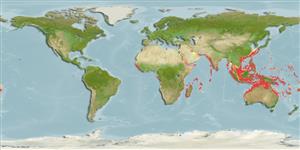Elasmobranchii
板鰓亞綱 (鯊魚與魟魚) (sharks and rays) >
Myliobatiformes (Stingrays)
鰩目 (Stingrays) >
Dasyatidae (Stingrays)
土魟科 (Stingrays) > Urogymninae
Etymology: Urogymnus: Greek, oura = tail + Greek, gymnos = naked (Ref. 45335).
More on authors: Bloch & Schneider.
Issue
Urogymnus africanus and Urogymnus asperrimus are considered synonyms and both are originally described in the same work. There is uncertainty about which name has priority, and thus both names can be found as valid; the first reviser is not researched (Eschmeyer, 2014).
Environment: milieu / climate zone / depth range / distribution range
生態學
海洋; 半鹹淡水 礁區魚類; 深度上下限 15 - 217 m (Ref. 86942). 熱帶; 31°N - 31°S, 20°W - 177°W
Indo-Pacific: Red Sea and coast of East Africa to the Marshall Islands and Fiji, south to northern Australia (Ref. 2334). Eastern Atlantic: Senegal, Guinea, and Côte d'Ivoire (Ref. 4438).
印度-太平洋: 紅海與東非海岸到馬紹爾群島與斐濟, 南至澳洲北部。 (參考文獻 2334) 東大西洋: 塞內加爾,幾內亞與象牙海岸.(參考文獻 4438)
Length at first maturity / 大小 / 重量 / 年齡
Maturity: Lm ?, range 100 - ? cm
Max length : 147 cm WD 雄魚/尚未辨別雌雄; (Ref. 58048)
Diagnosis: A heavily armored stingray lacking a venomous barb; young with large, flat denticles on upper surface, and large juveniles and adults with additional sharp conical thorns and small, pointed denticles (Ref. 5578).
一個甲冑很厚的魟沒有毒刺; 幼魚有在上表皮上的大又平坦的細齒,而且大的稚魚與成魚有額外的銳利錐形刺與小又尖的細齒。 (參考文獻 5578) 非常厚的瘦長寬廣地體盤有圓形的外角; 吻寬廣地圓的與尾部細長的, 大約與身體一樣長而且沒有鰭褶.(參考文獻 5578) 淺灰色或微白色的背面, 腹側白色的; 尾部黑色的.(參考文獻 5578)
Inhabits the continental shelf area (Ref. 2334), but capable of entering coastal lagoons (Ref. 81259). Found on sand and coral rubble areas near reefs (Ref. 9840), often in caves. Ovoviviparous (Ref. 50449). Due to its difficult handling, it is probably of limited commercial value (Ref. 9840). Its thorn can inflict a painful injury; caught commonly by demersal tangle net fisheries; utilized for its meat, skin (very high value) and cartilage (Ref.58048).
棲息於大陸棚區域。 棲息於在礁 (參考文獻 9840) 附近的沙子與珊瑚殘礫區域了, 常見於洞穴中。 卵胎生的.(參考文獻 50449) 由於它的困難處理, 它可能是商業價值有限.(參考文獻 9840)
Life cycle and mating behavior
成熟度 | 繁殖 | 產卵場 | 卵 | 孕卵數 | 仔魚
Exhibit ovoviparity (aplacental viviparity), with embryos feeding initially on yolk, then receiving additional nourishment from the mother by indirect absorption of uterine fluid enriched with mucus, fat or protein through specialised structures (Ref. 50449). Distinct pairing with embrace (Ref. 205). Distinct pairing with embrace (Ref. 205).印度-太平洋: 紅海與東非海岸到馬紹爾群島與斐濟, 南至澳洲北部。 (參考文獻 2334) 東大西洋: 塞內加爾,幾內亞與象牙海岸.(參考文獻 4438)
Randall, J.E., G.R. Allen and R.C. Steene, 1990. Fishes of the Great Barrier Reef and Coral Sea. University of Hawaii Press, Honolulu, Hawaii. 506 p. (Ref. 2334)
IUCN 瀕危狀態 (Ref. 130435: Version 2024-2)
瀕危 (EN) (A2cd); Date assessed: 16 June 2023
人類使用
漁業: 商業性
工具
特別的報告
下載 XML
網路資源
Estimates based on models
Preferred temperature (Ref.
123201): 25.4 - 29.3, mean 28.5 °C (based on 2874 cells).
Phylogenetic diversity index (Ref.
82804): PD
50 = 0.5156 [Uniqueness, from 0.5 = low to 2.0 = high].
Bayesian length-weight: a=0.01023 (0.00486 - 0.02155), b=3.06 (2.87 - 3.25), in cm total length, based on LWR estimates for this (Sub)family-body shape (Ref.
93245).
營養階層 (Ref.
69278): 3.5 ±0.46 se; based on food items.
回復力 (Ref.
120179): 低的, 最小族群倍增時間4.5 - 14 年 (Assuming fecundity<100).
Fishing Vulnerability (Ref.
59153): Very high vulnerability (90 of 100).
Nutrients (Ref.
124155): Calcium = 5.12 [0.57, 77.92] mg/100g; Iron = 0.354 [0.028, 3.818] mg/100g; Protein = 21.4 [18.7, 24.1] %; Omega3 = 0.0888 [, ] g/100g; Selenium = 41.6 [7.4, 202.0] μg/100g; VitaminA = 20.7 [1.8, 237.0] μg/100g; Zinc = 0.791 [0.052, 9.041] mg/100g (wet weight);
